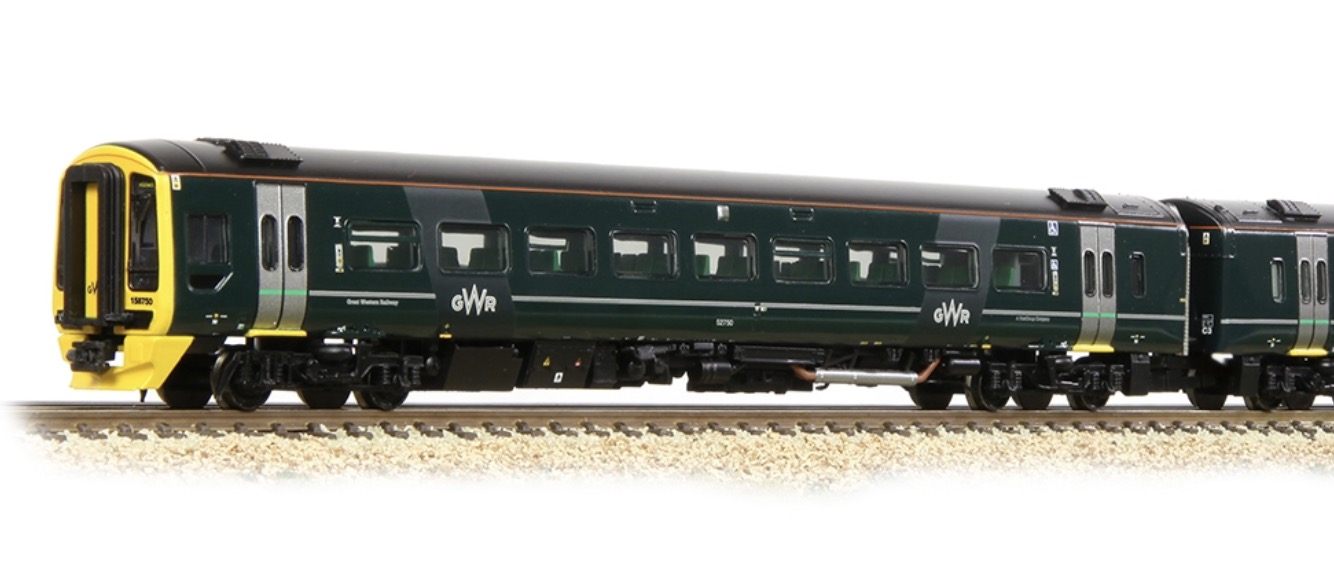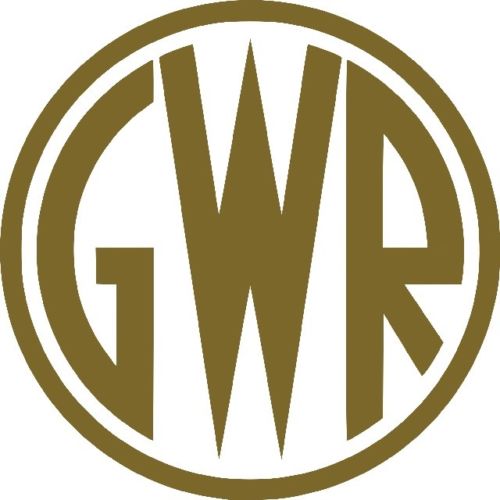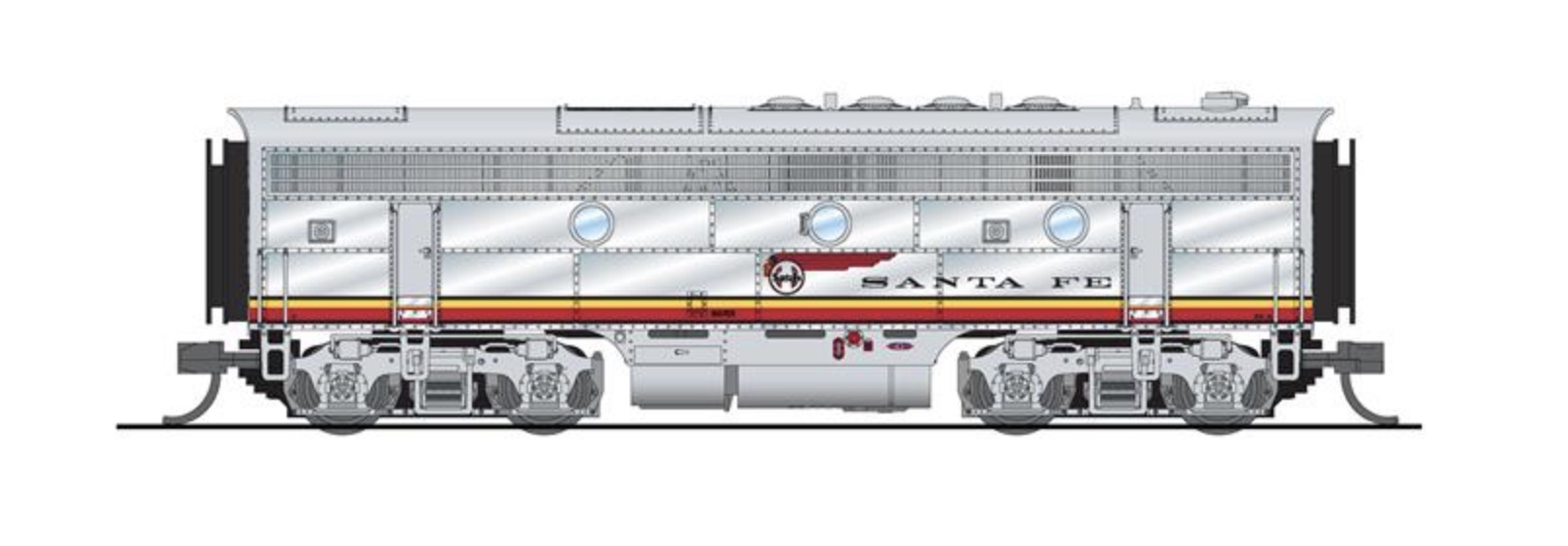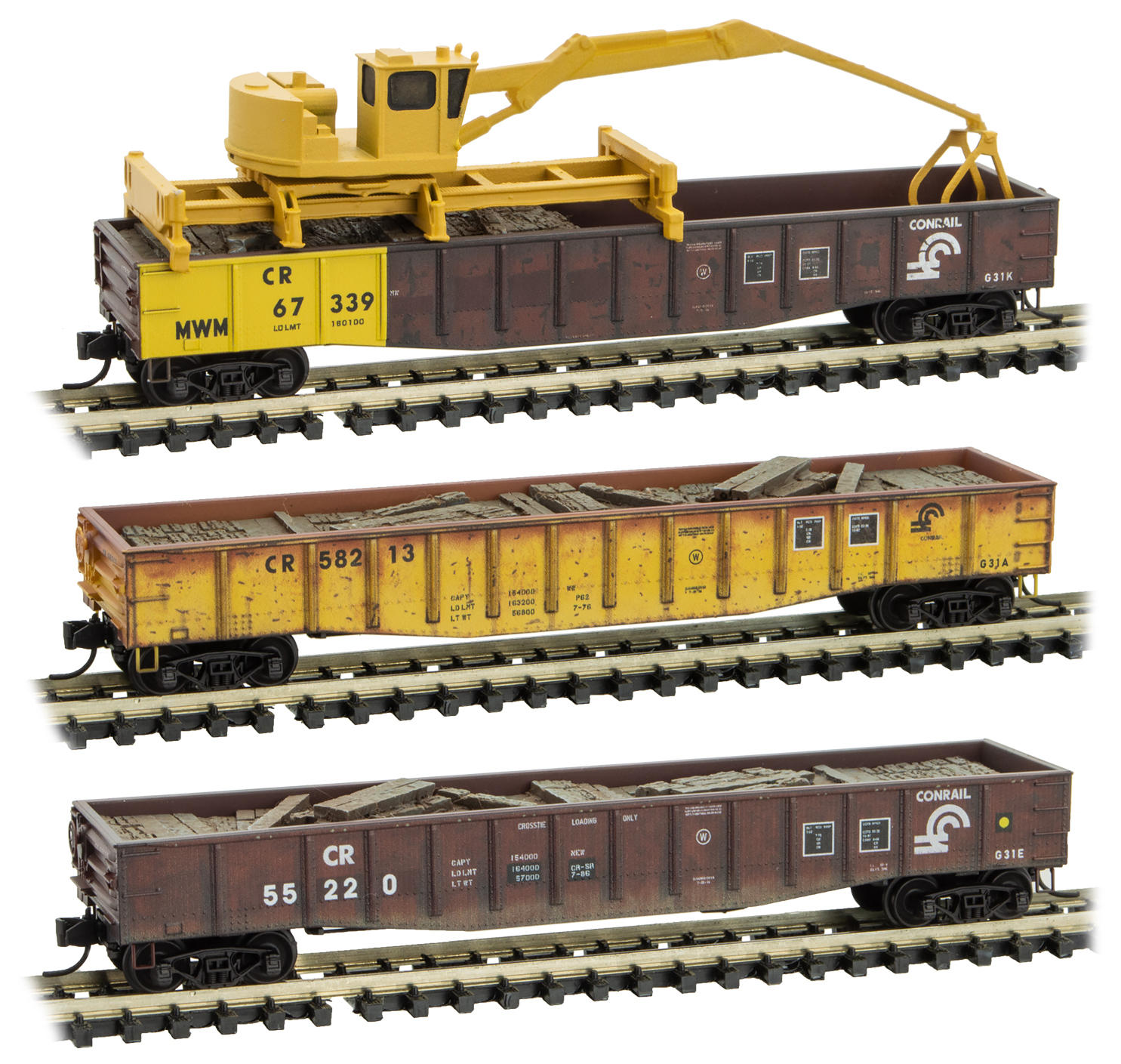Specific Item Information: The Class 158 is one of British Rail’s most successful second generation Diesel Multiple Units (DMUs); first introduced in 1989, all but one of the original units remain in traffic to this day. This all-new Graham Farish model follows in the footsteps of the brand’s award winning Class 319 Electric Multiple Unit and captures this iconic prototype to a tee.
The pinnacle of N scale second generation DMUs, the Graham Farish Class 158 combines high fidelity bodyshells with an underframe that’s adorned with separate components depicting the engines, electrical equipment, and auxiliary gear. It’s the livery application which really brings these models to life and every element has been replicated in miniature. Whilst the main colours are spray painted, the myriad smaller logos, symbols and lettering are applied using a specialist printing process, using BR and corporate specification fonts, logos and colours.
Driven by the low-level drive mechanism, each vehicle sports uninterrupted views of the interior which is fitted out with tables, chairs and even metal luggage racks – made visible thanks to the saloon lighting. The inter-vehicle coupling system ensure that the two vehicles work together in harmony and enables the use of a single decoder for DCC operation. Fitting that decoder couldn’t be easier thanks to the clip-off underframe panel behind which the decoder socket is fitted and combined with the pre-fitted speaker, it’s easy to fit sound to your model, or why not let us do the work for you by choosing a SOUND FITTED model for a fully immersive operating experience straight out of the box.
The pinnacle of N scale second generation DMUs, the Graham Farish Class 158 combines high fidelity bodyshells with an underframe that’s adorned with separate components depicting the engines, electrical equipment, and auxiliary gear. It’s the livery application which really brings these models to life and every element has been replicated in miniature. Whilst the main colours are spray painted, the myriad smaller logos, symbols and lettering are applied using a specialist printing process, using BR and corporate specification fonts, logos and colours.
Driven by the low-level drive mechanism, each vehicle sports uninterrupted views of the interior which is fitted out with tables, chairs and even metal luggage racks – made visible thanks to the saloon lighting. The inter-vehicle coupling system ensure that the two vehicles work together in harmony and enables the use of a single decoder for DCC operation. Fitting that decoder couldn’t be easier thanks to the clip-off underframe panel behind which the decoder socket is fitted and combined with the pre-fitted speaker, it’s easy to fit sound to your model, or why not let us do the work for you by choosing a SOUND FITTED model for a fully immersive operating experience straight out of the box.
Road Name History: The Great Western Railway (GWR) was a British railway company that linked London with the south-west and west of England, the Midlands, and most of Wales. It was founded in 1833, received its enabling Act of Parliament on 31 August 1835 and ran its first trains in 1838. It was engineered by Isambard Kingdom Brunel, who chose a broad gauge of 7 ft (2,134 mm)—later slightly widened to 7 ft 1⁄4 in (2,140 mm)—but, from 1854, a series of amalgamations saw it also operate 4 ft 8 1⁄2 in (1,435 mm) standard-gauge trains; the last broad-gauge services were operated in 1892. The GWR was the only company to keep its identity through the Railways Act 1921, which amalgamated it with the remaining independent railways within its territory, and it was finally merged at the end of 1947 when it was nationalised and became the Western Region of British Railways.
The GWR was called by some "God's Wonderful Railway" and by others the "Great Way Round" but it was famed as the "Holiday Line", taking many people to English and Bristol Channel resorts in the West Country as well as the far south-west of England such as Torquay in Devon, Minehead in Somerset, and Newquay and St Ives in Cornwall. The company's locomotives, many of which were built in the company's workshops at Swindon, were painted a Brunswick green colour while, for most of its existence, it used a two-tone "chocolate and cream" livery for its passenger coaches. Goods wagons were painted red but this was later changed to mid-grey.
Great Western trains included long-distance express services such as the Flying Dutchman, the Cornish Riviera Express and the Cheltenham Spa Express. It also operated many suburban and rural services, some operated by steam railmotors or autotrains. The company pioneered the use of larger, more economic goods wagons than were usual in Britain. It operated a network of road motor (bus) routes, was a part of the Railway Air Services, and owned ships, docks and hotels.
From Wikipedia
The GWR was called by some "God's Wonderful Railway" and by others the "Great Way Round" but it was famed as the "Holiday Line", taking many people to English and Bristol Channel resorts in the West Country as well as the far south-west of England such as Torquay in Devon, Minehead in Somerset, and Newquay and St Ives in Cornwall. The company's locomotives, many of which were built in the company's workshops at Swindon, were painted a Brunswick green colour while, for most of its existence, it used a two-tone "chocolate and cream" livery for its passenger coaches. Goods wagons were painted red but this was later changed to mid-grey.
Great Western trains included long-distance express services such as the Flying Dutchman, the Cornish Riviera Express and the Cheltenham Spa Express. It also operated many suburban and rural services, some operated by steam railmotors or autotrains. The company pioneered the use of larger, more economic goods wagons than were usual in Britain. It operated a network of road motor (bus) routes, was a part of the Railway Air Services, and owned ships, docks and hotels.
From Wikipedia
Brand/Importer Information: Graham Farish is a British brand of N gauge model trains, that belongs to Bachmann Europe.
The company entered the model train business in the early 1950s, focusing on British OO gauge rolling stock, track and accessories.
In the 1970s, it started to produce N gauge models under the GRAFAR label. After the withdrawal of Lima and Minitrix from the UK market in the late 1980s, Graham Farish was the only major supplier of British outline models in N gauge, soon withdrawing from the OO scale market.
In 2001, Graham Farish was purchased by Kader Industries of Hong Kong, and absorbed by its subsidiary Bachmann Industries. Bachmann immediately closed the British manufacturing facility and moved production to China.
Bachmann have since increased the size of the Farish range, by duplicating models introduced to the Bachmann OO range; often, an OO scale Bachmann Branchline model is followed between 6 months to a year later by an N gauge Graham Farish model.
The company entered the model train business in the early 1950s, focusing on British OO gauge rolling stock, track and accessories.
In the 1970s, it started to produce N gauge models under the GRAFAR label. After the withdrawal of Lima and Minitrix from the UK market in the late 1980s, Graham Farish was the only major supplier of British outline models in N gauge, soon withdrawing from the OO scale market.
In 2001, Graham Farish was purchased by Kader Industries of Hong Kong, and absorbed by its subsidiary Bachmann Industries. Bachmann immediately closed the British manufacturing facility and moved production to China.
Bachmann have since increased the size of the Farish range, by duplicating models introduced to the Bachmann OO range; often, an OO scale Bachmann Branchline model is followed between 6 months to a year later by an N gauge Graham Farish model.
Manufacturer Information: Bachmann, a US company founded in 1835, was purchased by Kader Industries in 1987. Kader formed Bachmann Industries Europe in 1989 with their main UK headquarters in Moat Way, Barwell, Leicestershire, UK (former Palitoy location) and the following year launched the Bachmann Branchline range for the British market with the moulds that had previously been used for the Palitoy Mainline and Replica Railways model railway products. From this starting point Bachmann has developed the range further and now produce a large range of models.
In 2001 Bachmann Branchline bought Graham Farish, an N gauge manufacturer, and since then many of their models have been made available in both gauges.
Bachmann Europe portfolio also comprises other model trains brands such as Liliput.
In 2001 Bachmann Branchline bought Graham Farish, an N gauge manufacturer, and since then many of their models have been made available in both gauges.
Bachmann Europe portfolio also comprises other model trains brands such as Liliput.
Item created by: CNW400 on 2024-03-13 17:02:26. Last edited by CNW400 on 2024-03-13 17:02:27
If you see errors or missing data in this entry, please feel free to log in and edit it. Anyone with a Gmail account can log in instantly.
If you see errors or missing data in this entry, please feel free to log in and edit it. Anyone with a Gmail account can log in instantly.











